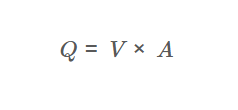1. What is an Airflow Rate Calculator for HVAC Systems?
Definition: This calculator computes the airflow rate (\( Q \)) in a duct or pipe using the velocity and cross-sectional area.
Purpose: It is used in HVAC systems to determine the volume of air flowing through a duct, essential for system design, fan selection, and ensuring proper ventilation.
2. How Does the Calculator Work?
The calculator uses the airflow rate formula:
Airflow Rate:
\[
Q = V \times A
\]
Where:
- \( Q \): Airflow rate (cfm, m³/s)
- \( V \): Velocity (ft/s, m/s)
- \( A \): Cross-sectional area (ft², in², m²)
Unit Conversions:
- Velocity (\( V \)): ft/s, m/s (1 m/s = 3.28084 ft/s)
- Cross-Sectional Area (\( A \)): ft², in² (1 in² = \( \frac{1}{144} \) ft²), m² (1 m² = 10.7639 ft²)
- Airflow Rate (\( Q \)): cfm (1 ft³/s = 60 cfm), m³/s (1 ft³/s = 0.0283168 m³/s)
Steps:
- Enter the velocity and cross-sectional area, and select their units.
- Convert all inputs to base units (ft/s for velocity, ft² for area).
- Calculate the airflow rate using \( Q = V \times A \) (result in ft³/s).
- Convert the result to the selected unit (cfm, m³/s).
- Display the result, using scientific notation for values less than 0.001, otherwise with 4 decimal places.
3. Importance of Airflow Rate Calculation in HVAC Systems
Calculating the airflow rate is crucial for:
- HVAC Design: Ensures proper sizing of ducts and fans to deliver adequate ventilation and maintain air quality.
- Energy Efficiency: Helps optimize airflow to reduce energy consumption in HVAC systems.
- System Performance: Allows for accurate assessment of airflow to meet heating, cooling, and ventilation requirements.
4. Using the Calculator
Examples:
- Example 1: For \( V = 10 \, \text{ft/s} \), \( A = 2 \, \text{ft}^2 \), airflow rate in cfm:
- Airflow Rate: \( Q = 10 \times 2 = 20 \, \text{ft}^3/\text{s} \)
- Convert to cfm: \( Q = 20 \times 60 = 1200.0000 \, \text{cfm} \)
- Example 2: For \( V = 5 \, \text{m/s} \), \( A = 1 \, \text{m}^2 \), airflow rate in m³/s:
- Convert: \( V = 5 \times 3.28084 = 16.4042 \, \text{ft/s} \), \( A = 1 \times 10.7639 = 10.7639 \, \text{ft}^2 \)
- Airflow Rate: \( Q = 16.4042 \times 10.7639 = 176.5744 \, \text{ft}^3/\text{s} \)
- Convert to m³/s: \( Q = 176.5744 \times 0.0283168 = 5.0000 \, \text{m}^3/\text{s} \)
5. Frequently Asked Questions (FAQ)
Q: What is airflow rate in HVAC systems?
A: Airflow rate (\( Q \)) is the volume of air passing through a duct per unit time, calculated as \( Q = V \times A \).
Q: Why is airflow rate important in HVAC systems?
A: It ensures proper ventilation, maintains air quality, and optimizes energy efficiency by correctly sizing ducts and fans.
Q: How do I measure velocity and area in a duct?
A: Use an anemometer to measure velocity and calculate the cross-sectional area by measuring the duct's dimensions (e.g., width × height for a rectangular duct).
Airflow Rate Calculator© - All Rights Reserved 2025
 Home
Home
 Back
Back
